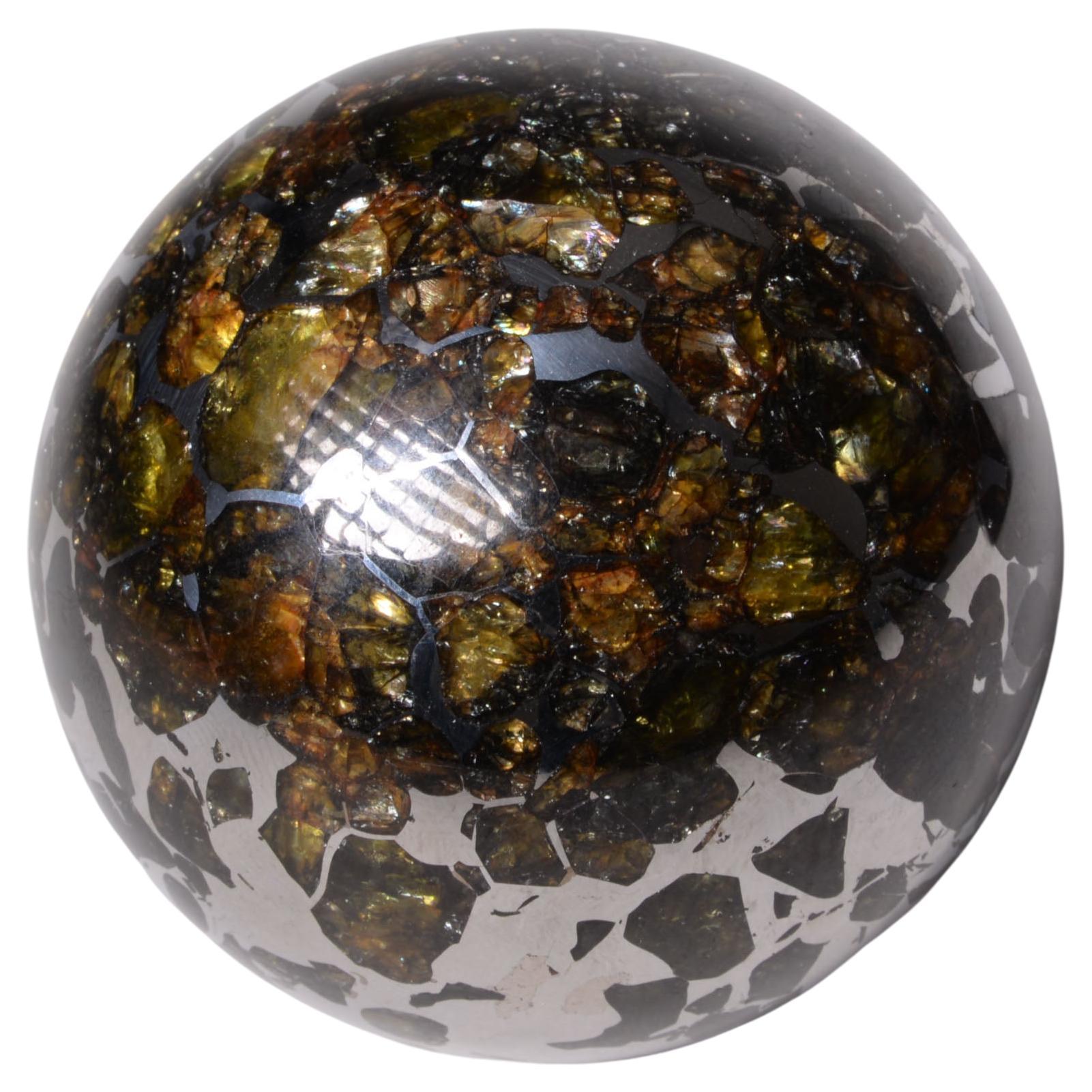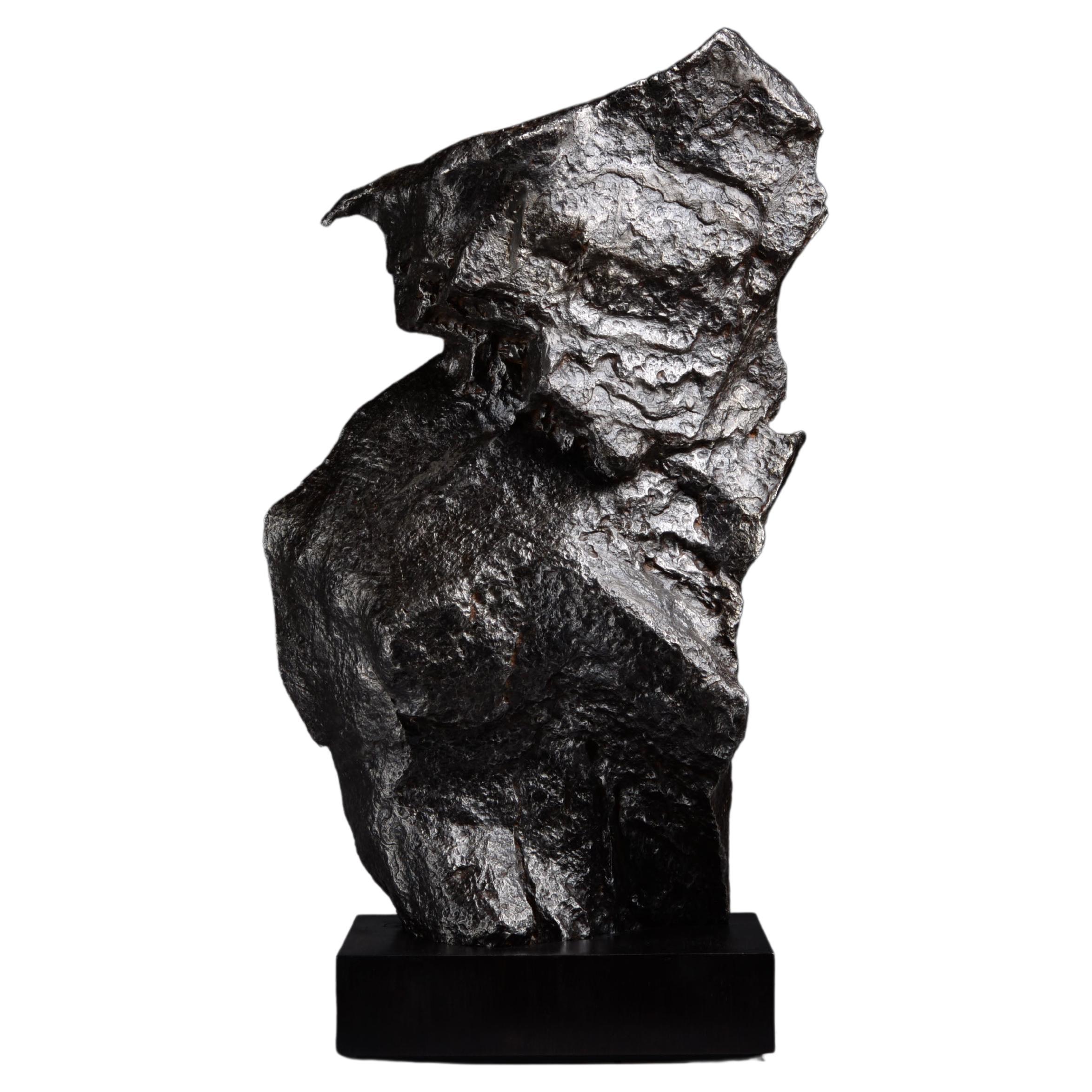Want more images or videos?
Request additional images or videos from the seller
1 of 6
Lunar Meteorite
About the Item
A beautiful fragment from a lunar meteorite, among the rarest of all geological finds. This specimen belongs to NWA 11303, a feldspathic regolith breccia which formed when the shock wave caused by an asteroid impact turned the fine-grained soil (or regolith) covering the surface of the lunar highlands into rock. Ejected from the Moon by the impact, it travelled hundreds of thousands of miles before falling to Earth. It then lay hidden among the sand dunes, blasted by the desert winds, before its discovery at a site near Tindouf, Algeria, in 2017. The dark grey stone has large white inclusions and a sand-polished, beautifully weathered desert patina. Cuts on one side to reveal a fine-grained matrix with diffuse large whitish to black clasts.
Many lunar surface samples were recovered during the Apollo missions. However, these could only be sampled from sites which were safe for humans and therefore only illustrate a small portion of the Moon’s surface. Lunar meteorites found on Earth offer a much better picture of the composition of the lunar surface, since they originate from many different areas of the Moon. The very first specimen was discovered on 17 January 1982, a decade after the last Apollo mission, and those recovered since have proved invaluable to the understanding of the history and geological evolution of the Moon. These lunar meteorites are extremely rare - when pairing together known specimens coming from the same meteoroid, only about a hundred are known.
Petrography:
(A. Irving and S. Kuehner, UWS) Breccia composed of angular mineral grains of anorthite, olivine, orthopyroxene, exsolved pigeonite, ferroan pigeonite, augite, ilmenite, Ti-chromite and fayalite in a partly vesicular matrix containing minor kamacite and barite.
Geochemistry:
Olivine (Fa26.7-47.2, FeO/MnO = 75-81, N = 2), orthopyroxene (Fs24.1Wo3.6, FeO/MnO = 67), orthopyroxene host (Fs47.1Wo3.3, FeO/MnO = 68), ferroan pigeonite (Fs52.4Wo18.8, FeO/MnO = 67), augite (Fs8.0Wo44.3, FeO/MnO = 35), plagioclase (An96.7-97.4Or0.2-0.1, N = 2).
Published:
Meteoritical Bulletin, no. 107, 2018.
- Dimensions:Height: 3.15 in (8 cm)Diameter: 2.96 in (7.5 cm)
- Materials and Techniques:
- Place of Origin:
- Period:
- Date of Manufacture:4.5 Billion y/o
- Condition:
- Seller Location:London, GB
- Reference Number:
About the Seller
5.0
Recognized Seller
These prestigious sellers are industry leaders and represent the highest echelon for item quality and design.
Established in 2008
1stDibs seller since 2014
100 sales on 1stDibs
Typical response time: 7 hours
Associations
LAPADA - The Association of Arts & Antiques DealersInternational Confederation of Art and Antique Dealers' AssociationsThe British Antique Dealers' Association
- ShippingRetrieving quote...Ships From: London, United Kingdom
- Return PolicyA return for this item may be initiated within 14 days of delivery.
More From This SellerView All
- Cross Section of Exceptional Lunar MeteoriteLocated in London, GB“This 149-gram slice of the Gadamis 004 lunar meteorite contains a wide variety of sizes of light-colored angular anorthositic clasts. These silicate c...Category
Antique 15th Century and Earlier Libyan Natural Specimens
MaterialsStone
- Cross-Section from an Exceptional Lunar MeteoriteLocated in London, GBA piece of the moon - superb lunar meteorite gadamis 004 - Anorthosite 4.5 Billion y/o Among the rarest substances to be found on Earth, thi...Category
Antique 15th Century and Earlier Libyan Natural Specimens
MaterialsStone
- Seymchan Meteorite SphereLocated in London, GBSeymchan Sphere Pallasite 291 g Comprising less than 0.2% of all meteorites, pallasites, made up of an iron-nickel matrix interwoven with amber-coloured olivine gemstones, are the most dazzling meteorites of all. This piece, extracted from the Seymchan meteorite...Category
Antique 15th Century and Earlier Russian Natural Specimens
MaterialsIron
- Monolithic Stone MeteoriteLocated in London, GBUnclassified Meteorite Stone Height: 36.83 cm 42.5 kg A dramatic extraterrestrial sculpture, of monolithic form, covered in a thick grey-brown fusion crust and with areas of sandy deposits from untold years spent on the desert floor. Formed in the asteroid belt between Mars and Jupiter during the formation of our solar system, some 4.55 billion years ago, this large stone would have been separated from its parent body by an enormous impact before journeying through interplanetary space and eventually reaching Earth. Upon atmospheric entry it would have reached cosmic velocity, heating the surrounding air to 1700°C and producing a large ball of fire. The heat was sufficient to melt the outer surface of the stone, exposing a new surface which in turn also melted away, losing as much as 95% of its initial mass before reaching the ground. The last molten layer to form as it collided with the Earth covered the stone in a layer of fusion crust, evidence of the incredible impact force delivered by this extraordinary specimen. “This unclassified stone meteorite was found in Northwest Africa. It has a relatively smooth, dark brown, slightly weathered fusion crust; some small melt veins are visible on the surface. Due to the near-absence of terrestrial rocks in this region of the Sahara, meteorite hunting in this area has yielded many notable discoveries.” Dr Alan E. Rubin, PhD Department of Earth, Planetary, and Space Sciences...Category
Antique 15th Century and Earlier North African Natural Specimens
MaterialsStone
- Large Sculptural MeteoriteLocated in London, GBA magnificent and extremely sculptural specimen of the Seymchan meteorite, recovered in the Russian Far East. This rare and large end cut preserves the patinated and partially melted...Category
Antique 15th Century and Earlier Russian Natural Specimens
MaterialsOther
- Sculptural Oriented MeteoriteLocated in London, GBOriented Chondrite Meteorite Circa 4.56 Billion y/o Chondrite 24 x 20 cm, 28 cm tall on base 7.1 kg A sculptural and beautifully weathered chondrite meteorite; upon entering the atmosphere, this extraterrestrial stone would have heated the surrounding air to a temperature of over 1700 C, higher than that of the hottest lava on the planet, and enough to melt away its outer layers, leaving its surface rippled with regmaglypts, thumb-shaped impressions formed as superheated rock streaked off of the main body as it careened toward the earth. The last layer of the rock to melt would have re-solidified as the meteorite made impact, forming a charcoal coloured fusion crust, which has taken on a deep ochre-tinted patina. Chondrite meteorites such as this example were formed at the very beginning of our solar system, by the accretion of various types of dust and small grains, adrift in the vacuum of space and, as such, provide important clues about the birth of our own planet. This piece is an especially rare specimen, known as an oriented meteorite...Category
Antique 15th Century and Earlier Natural Specimens
MaterialsStone
You May Also Like
- Franconia MeteoriteLocated in New York, NYFound in 2002 at Franconia in Mojave, Arizona, this H5 chondrite meteorite can be found strewn amongst many other varieties of metorite in what has been coined a Dense Collection Are...Category
Antique 15th Century and Earlier American Natural Specimens
MaterialsOther
- Brahin Pallasite Meteorite SliceLocated in New York, NYThis meteorite was acquired from the Bethany Sciences collection and was once a part of the private collection of Meteorite Man Robert A. Haag. It includes an informational Certifica...Category
Antique 15th Century and Earlier Belarusian Natural Specimens
MaterialsCrystal, Other
- Genuine Muonionalusta Meteorite (5.5 grams)Located in New York, NYGenuine Muonionalusta Meteorite Slice from Norrbotten, Sweden. The Muonionalusta is a meteorite classified as fine octahedrite, type IVA (Of) which impacted in northern Scandinavia,...Category
21st Century and Contemporary Swedish Natural Specimens
MaterialsRock Crystal
- 24 Gram Brahin Meteorite SliceLocated in New York, NYThis meteorite was acquired from the Bethany Sciences collection and was once a part of the private collection of Meteorite Man Robert A. Haag. It includes an informational Certifica...Category
Antique 15th Century and Earlier Belarusian Natural Specimens
MaterialsCrystal, Other
- Seymchan Corner-Cut Pallasite MeteoriteLocated in New York, NYThe Seymchan meteorite is a pallasite meteorite found in Russia in the settlement of Seymchan. Discovered in 1967, it is one of only a few pallasite meteorites - a type of meteorite ...Category
Antique 15th Century and Earlier Russian Natural Specimens
MaterialsOther
- Soledade Meteorite Slice // 389 GramsLocated in New York, NYThis hefty approximately over 4.5 billion year old Soledade iron meteorite slice features a prominent, unique iron nickel etching. This octahedrite was discovered in 1986 as a 68 kg ...Category
Antique 15th Century and Earlier Brazilian Natural Specimens
MaterialsOther, Iron, Nickel





